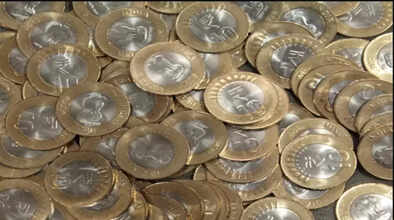10 Rupee Coin: Are you carrying a fake 10 Rupee coin? Here's how to identify the real one..

Rumors often circulate about the 50-rupee coin. This has led many shopkeepers to shy away from accepting 10-rupee coins. However, you might be surprised to learn that a total of 14 different designs of 10 rupee coins have been introduced into the market. The central bank has provided complete information about all these designs on its website. Nevertheless, as soon as rumors of counterfeit coins emerge, shopkeepers and the public become wary of accepting them. People often wonder whether a coin is genuine or fake by looking at the stripes or the placement of the rupee symbol on the coin. So, let's explore the easiest and most accurate way to identify a genuine 10 rupee coin, so you never have to worry about this.
Coin Designs Keep Changing
The Reserve Bank of India has clearly stated that coin designs and patterns change from time to time. This does not mean that a new or different-looking coin is fake. For example, 10 rupee coins issued in 2009 had 15 stripes. Later, in the coins issued in 2011, the number of stripes was reduced to 10, and the rupee symbol was placed above the 10. Both types of coins are legal tender. Therefore, it is wrong to assume a coin is fake based on its appearance alone. The RBI says that all legal 10 rupee coins in the market should be accepted in transactions.
If a shopkeeper refuses to accept a coin, do this.
If a shopkeeper refuses to accept your 10-rupee coin, there's no need to panic. You can easily go to the nearest bank and have the coin inspected. The bank sends suspicious coins to the RBI. If the coin is found to be genuine, you will get it back. If it turns out to be fake, further legal proceedings may be initiated.
By law, all banks are required to accept legal coins and issue notes in exchange. Those who refuse to accept coins without reason may face charges under the Indian Penal Code. 10 rupee coins are generally accepted without suspicion at places like railway ticket counters, toll plazas, post offices, supermarkets, and malls.
10 rupee coins are very difficult to counterfeit.
Fake coins are not as easy to counterfeit as counterfeit notes. According to information from 2018, the cost of making a 10 rupee coin was approximately 5.54 rupees. Today, prices will have risen, which means the cost of making coins is bound to increase. The expense and labor required to make counterfeit coins often make the business unprofitable.
Furthermore, it is difficult to replicate the finish and quality of coins. Counterfeit coins often attempt to imitate old designs, but lack the original's coating, delicate edges, and shine. Therefore, counterfeit coins generally have a low circulation. However, if you want to determine the authenticity of a 10 rupee coin, you can use these simple methods.
Weight and Metal: The 10 rupee coin is made of two types of metals. The outer layer is made of aluminum-bronze, and the center layer is made of nickel-bronze. Counterfeit coins may be dull or uneven in color, and their weight may vary. Genuine coins are shiny and precise.
Design and Engraving: The coin features the Ashoka Pillar and the inscription Bharat (India). The reverse side may feature 10 Rupees and a special symbol, such as a lotus flower. Genuine coins have fine lines on the edges. The engraving on counterfeit coins may be blurred or inaccurate.
Drop Sound and Magnet Test: A genuine coin makes a clear, metallic sound when dropped, while a counterfeit coin produces a hollow sound. A genuine coin is slightly magnetic and attracts a magnet slightly, while a counterfeit coin has either very little or no attraction.
Information Number: The Reserve Bank has issued a toll-free number, 14440, for information on 10 rupee coins. You can also call to get complete information about the coins.
Disclaimer: This content has been sourced and edited from TV9. While we have made modifications for clarity and presentation, the original content belongs to its respective authors and website. We do not claim ownership of the content.

